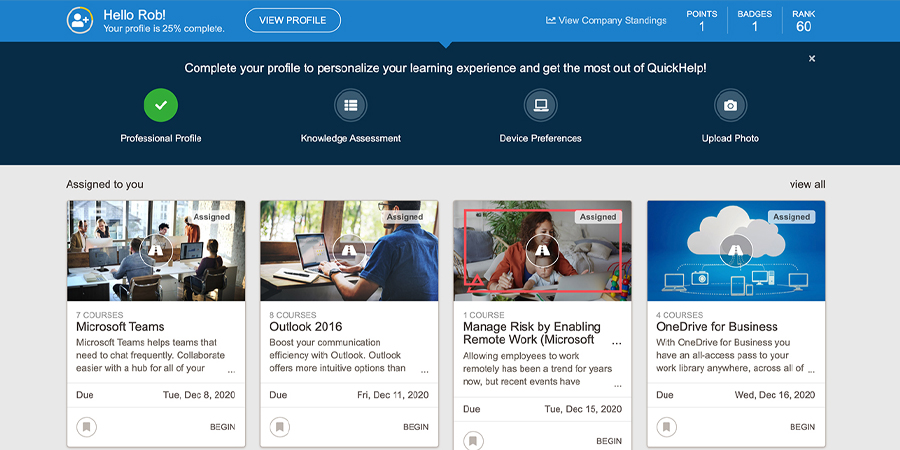
It’s hard to imagine a modern successful business that has no focus on employees’ education. To make the process of education comfortable and effective, BrainStorm together with Intellias develops QuickHelp, a cloud online platform for corporate education.
Operating on a $200 billion market of online education, BrainStorm is growing fast on. The QuickHelp platform has over 2 million active users, including global leaders like Visa, NASA, PepsiCo, and Deloitte. For over eight years the Intellias team has been effectively developing this digital product.

QuickHelp is an educational platform for big corporations, where employees are taught to work with software using various webinars and online courses. Having their individual learning plans, users can watch educational materials and test their knowledge. The platform also offers onboarding courses for beginners to help them understand the company’s organization, boost their motivation, and learn interesting things about their projects and teams.
When BrainStorm signed Intellias to work on the platform, we only had one person on this project. For eight years, we’ve been building trustful relations with the client and using our profound expertise to help them grow their business. Now the Intellias team, that works on QuickHelp, has 60 people on board and plans to hire 30 more in the nearest time. We’ve became the key technical partner of BrainStorm. Our engineers are responsible for developing the platform, making technical and architectural decisions. The BrainStorm team mostly consists of product owners, who set their requirements for product functionality, paint the bigger picture for our engineers and always stay in touch.
Our online learning product has evolved from a simple utility to an interactive platform. The next step would be to develop a new microservice platform with an embedded business model that meets market requirements. The new platform is designed to attract new users and address the following issues:
Both platforms are written in C#. For the current platform we also use the .NET Framework 4.62. The latest versions of .NET Standart and .NET Core are used for the new platform. React is used to write web portals for both platforms, except for the current platform’s EUP, which is based on Angular. The platforms are hosted in Azure and built accordingly using all the necessary Azure resources. CI/CD processes with practices/approaches (Code Review, SCA, Auto-testing, BuildOnce, DeployMany, IaaC, and so on) are used to deliver functionality/features. With their help, we can quickly estimate the quality of functionality/features in the early stages and bring it out to the end environment. Overall, everything is hosted in Azure or Azure App Service combined with serverless Azure Func for the current platform. Since the new platform is based on Microservices architecture, the services are already packaged in Doker Container Image. In the future, they will be orchestrated under Azure Kubernetes Service (AKS).

Our philosophy on the project can be described as less formal processes. We adjust all processes exclusively to our tasks. The clients don’t limit us in our work: we can suggest and implement the practices that we think are needed. Based on our own experience, the experience of Spotify and the LessHuge framework, we’ve built a flexible project structure with self-organized teams. While having their areas of responsibilities, self-organized teams have no fixed roles and can change them if needed. The team itself decides how to distribute responsibilities among all the team members to achieve business goals. On average, one team consists of 4-5 developers and a QA. Outside of the functional teams, we have executives who support the project, including BA, Automation QA, Tech Lead, DevOps, Data Base dev, etc.
To ensure free exchange of ideas, we have guilds (Spotify Guilds) on the project. These are horizontal associations of active people from different teams. We have guilds dedicated to Architecture, QA, DevOps and others, but overall, any specialist can join any guild. Their main goal is to share expertise, suggest ideas for product improvement, and explore new technologies.
BrainStorm is a project that allows you to explore new things and unleash your potential. You can try a new technology or a new role. For example, one of our QAs became a developer, and one of our developers moved to a managerial position. Other projects usually have strict frameworks and therefore limit people’s freedom of shifting to new roles.
By solving complex technical problems, we earned our client’s trust but we also took a bigger responsibility for the end results. Our team members don’t just do their tasks, they always keep product’s and business’ goals in mind. What we do is basically product development. The team keeps end users’ needs in mind and cares about their business problems. For us, product success equals team success.
Our plans in platform development include:
We are constantly looking for new specialists to join the team, who want to grow their expertise and improve the product. This is how we manage to gather an ambitious and talented team that shapes the future of corporate training.
Brainstorm QuickHelp project

The best vacancies, are waiting for you!
We picked vacancies that suit your skills!



